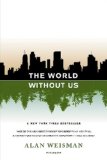Summary | Excerpt | Reviews | Beyond the Book | Readalikes | Genres & Themes | Author Bio

Critics' Opinion:
Readers' Opinion:
First Published:
Jul 2007, 336 pages
Paperback:
Aug 2008, 368 pages
 Book Reviewed by:
Book Reviewed by:
BookBrowse Review Team
Buy This Book
Chapter 9: Polymers are Forever
The port of Plymouth in southwestern England is no longer
listed among the scenic towns of the British Isles, although prior to World War
II it would have qualified. During six nights of March and April 1941, Nazi
bombs destroyed 75,000 buildings in what is remembered as the Plymouth Blitz.
When the annihilated city center was rebuilt, a modern concrete grid was
superimposed on Plymouth's crooked cobbled lanes, burying its medieval past in
memory.
But the main history of Plymouth lies at its edge, in the
natural harbor formed at the confluence of two rivers, the Plym and the Tamar,
where they join the English Channel and the Atlantic Ocean. This is the Plymouth
from which the Pilgrims departed; they named their American landfall across the
sea in its honor. All three of Captain Cook's Pacific expeditions began here, as
did Sir Francis Drake's circumnavigation of the globe. And, on December 27,
1831, H.M.S. Beagle set sail from Plymouth Harbor, with 22-year-old Charles
Darwin aboard.
University of Plymouth marine biologist Richard Thompson
spends a lot of time pacing Plymouth's historic edge. He especially goes in
winter, when the beaches along the harbor's estuaries are empty—a tall man in
jeans, boots, blue windbreaker, and zippered fleece sweater, his bald pate
hatless, his long fingers gloveless as he bends to probe the sand. Thompson's
doctoral study was on slimy stuff that mollusks such as limpets and winkles like
to eat: diatoms, cyanobacteria, algae, and tiny plants that cling to seaweed.
What he's now known for, however, has less to do with marine life than with the
growing presence of things in the ocean that have never been alive at all.
Although he didn't realize it at the time, what has
dominated his life's work began when he was still an undergraduate in the 1980s,
spending autumn weekends organizing the Liverpool contingent of Great Britain's
national beach cleanup. In his final year, he had 170 teammates amassing metric
tons of rubbish along 85 miles of shoreline. Apart from items that apparently
had dropped from boats, such as Greek salt boxes and Italian oil cruets, from
the labels he could see that most of the debris was blowing east from Ireland.
In turn, Sweden's shores were the receptacles for trash from England. Any
packaging that trapped enough air to protrude from the water seemed to obey the
wind currents, which in these latitudes are easterly.
Smaller, lower-profile fragments, however, were apparently
controlled by currents in the water. Each year, as he compiled the team's annual
reports, Thompson noticed more and more garbage that was smaller and smaller
amid the usual bottles and automobile tires. He and another student began
collecting sand samples along beach strand lines. They sieved the tiniest
particles of whatever appeared unnatural, and tried to identify them under a
microscope. This proved tricky: their subjects were usually too small to allow
them to pinpoint the bottles, toys, or appliances from which they sprang.
He continued working the annual cleanup during graduate
studies at Newcastle. Once he completed his Ph.D. and began teaching at
Plymouth, his department acquired a Fourier Transform Infrared Spectrometer, a
device that passes a microbeam through a substance, then compares its infrared
spectrum to a database of known material. Now he could know what he was looking
at, which only deepened his concern.
"Any idea what these are?" Thompson is guiding a visitor
along the shore of the Plym River estuary, near where it joins the sea. With a
full moonrise just a few hours off, the tide is out nearly 200 meters, exposing
a sandy flat scattered with bladderwrack and cockle shells. A breeze skims the
tidal pools, shivering rows of reflected hillside housing projects. Thompson
bends over the strand line of detritus left by the forward edge of waves lapping
the shore, looking for anything recognizable: hunks of nylon rope, syringes,
topless plastic food containers, half a ship's float, pebbled remains of
polystyrene packaging, and a rainbow of assorted bottle caps. Most plentiful of
all are multicolored plastic shafts of cotton ear swabs. But there are also the
odd little uniform shapes he challenges people to identify. Amid twigs and
seaweed fibers in his fistful of sand are a couple of dozen blue and green
plastic cylinders about two millimeters high.
Copyright © 2007 by Alan Weisman. All rights reserved.





The Flower Sisters
by Michelle Collins Anderson
From the new Fannie Flagg of the Ozarks, a richly-woven story of family, forgiveness, and reinvention.

The House on Biscayne Bay
by Chanel Cleeton
As death stalks a gothic mansion in Miami, the lives of two women intertwine as the past and present collide.

The Funeral Cryer by Wenyan Lu
Debut novelist Wenyan Lu brings us this witty yet profound story about one woman's midlife reawakening in contemporary rural China.
Your guide toexceptional books
BookBrowse seeks out and recommends the best in contemporary fiction and nonfiction—books that not only engage and entertain but also deepen our understanding of ourselves and the world around us.